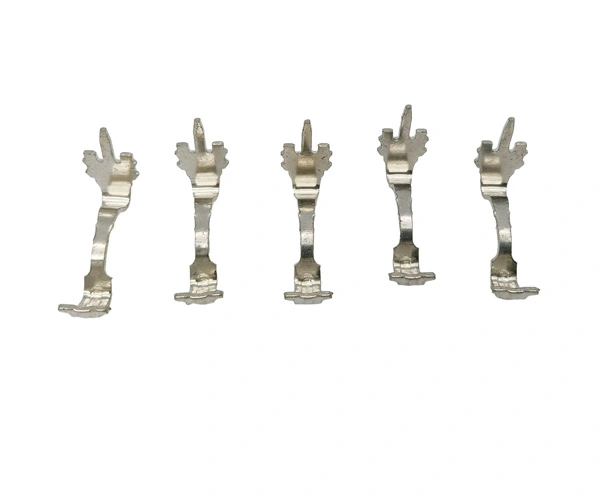

Material: Brass T2 T3 TU2/stainless steel/aluminum/copper/galvanized sheet available
Thickness: 0.5mm
Tolerance: ±0.05mm
Manufacturing process: progressive die stamping
Surface treatment: powder coating/painting/anodization/sandblasting/zinc coating etc available
Irregular pins, bent copper pins, various irregular pins
The main differences between single punch die and progressive stamping die are as follows:
1. Structure:
A single punch die usually only contains one mold, which is used to complete the one-time stamping forming of a single part. It requires repeating the steps of feeding, positioning, stamping, and returning to manufacture each part. one
Progressive stamping molds are composed of multiple continuous modules, including cutting or cutting tools, allowing for simultaneous cutting and production of multiple complete parts on the same set of molds. This design improves production and work efficiency.
2. Process flow:
The operation process of a single punching die includes independent processes such as feeding, positioning, stamping, and returning, which requires a series of separate operations for the production of each part.
Progressive die is achieved through a single feeding and positioning operation, followed by continuous stamping until all necessary processes are completed, thereby achieving efficient continuous production.
3. Production efficiency:
Due to the ability of continuous molds to process multiple parts at the same time, their production efficiency in mass production is much higher than that of single punch molds, which helps to shorten production time and reduce costs.
Due to its independent operation, single punch molds have relatively low production efficiency and are more suitable for small-scale production and manufacturing of complex parts.
4. Scope of application:
Continuous stamping molds are usually suitable for producing standardized simple parts, such as connectors and spring plates.
Single punching die is more suitable for manufacturing complex parts that require high machining accuracy and quality, such as car doors.
5. Working principle:
A single punching die can only complete one action to press the workpiece, and the number of actions is fixed.
Progressive stamping die can complete multiple stamping processes in one stamping stroke, with high efficiency.
6. Application scope:
Single punch molds are suitable for producing high-quality but small quantity workpieces.
Progressive stamping die is suitable for large-scale or periodic production situations.
In summary, both single punching die and progressive die have their own advantages and application scenarios, and their selection depends on the quality and quantity of the product as well as the production needs.
